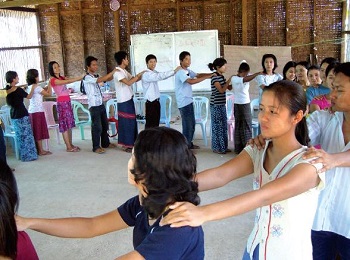Project
Deepening Democratization Processes Through Youth Leadership in Myanmar
- Myanmar
- September 2010
The project aimed to identify new youth fellows, train them in leadership and concepts of democracy and governance, and prepare them to lead development projects in their communities. The strategy to do this was through “placements” with local grassroots organizations. The 130 trained youth fellows were supported through the fellowship network, including meetings at local and state levels and by identifying 400 youth volunteers through community “reflect circles” that the fellows facilitated. Together, the fellows and volunteers led and established a large number of development projects within the communities, ranging from pig rearing to the building of early education centres.
The model is ideally suited to both produce the expected outcomes and also lay the groundwork for potential future representation at national level. The project far exceeded its own expectations, reaching more than 100,000 people through project activities. However, planned training of journalists and the development of a website proved not to be possible in the political climate in Myanmar and were replaced by the production of a series of newsletters for the fellows and for broader dissemination.
Lessons from Project
💡
- Youth engagement
- Myanmar
- September 2010
Apart from the obvious advantage of documenting all that has happened for internal use, clearly identifying outputs, outcomes and also lessons-learned is useful for attracting ongoing donor support and for underpinning future project design and implementation.
💡
- Youth engagement
- Myanmar
- September 2010
The original project design foresaw training of journalists and the placement of a number of articles in the media, but this was not done. The political realities of Myanmar, at a time of heightened political sensitivity around election, made working with the media – especially within a project clearly labelled “deepening democratization processes” – impossible. This should have been anticipated when the project was designed.
💡
- Youth engagement
- Myanmar
- September 2010
Where academic research is useful to initiate policy dialogue with the authorities, action-research can provide the opportunity for capacity building of the fellows and can also be a useful tool in deciding, designing and promoting community initiatives. Reliable research by a recognized researcher is more likely to be usable in policy dialogue with the authorities; action-research facilitated by trained fellows is more likely to be valid for informing community-level actions and discussion. There should be a clear distinction between the two, and better strategizing/positioning of the research within the project design.
💡
- Youth engagement
- Myanmar
- September 2010
The grantee continued to use the fellowship model in other countries, and a global youth forum hub has been relocated from Nepal to Myanmar. Within this project, community groups were also brought together at state level with a view to initiating a state-level process that would endure beyond the end of project activity and involve both local development practitioners and government functionaries.
💡
- Youth engagement
- Myanmar
- September 2010
One of the by-products of the project was the positive impact on partner organizations working at grassroots level. Although partners were chosen on the basis of their strengths and were treated within the project as equal partners, it was recognized that they did not necessarily have staff who were trained and experienced. The project therefore encouraged younger members of staff to sign up as fellows, and facilitated some fellows later joining as staff.
💡
- Youth engagement
- Myanmar
- September 2010
From the outset, the project design aimed to maintain appropriate gender balance and to ensure that women participated fully in the project. This is especially important in grassroots actions where women as leaders are not the norm in some parts of Myanmar. Of the 130 youth fellows involved in the project, 64 were women. Importantly, images of women leading workshops, taking the microphone in forums and participating equally in the project’s actions were included in newsletters and other publications. One newsletter was formally devoted to discussion of women’s rights.
💡
- Youth engagement
- Myanmar
- September 2010
The project was carefully planned to work within remaining restrictions and designed not to create conflict or controversy, to ensure that participants at the grassroots level were not put at unnecessary risk. Its design as part of a broader, longer-term undertaking means that it is embedded in processes that already have legitimacy among both communities and authorities.

💡
- Youth engagement
- Myanmar
- September 2010
The processes established in Myanmar have also attracted continuing donor interest and some elements are also being funded at the local level through fundraising. The majority of fellows are still active and are financing their own activities. As a component of a broader strategy, it was able to achieve outputs that exceeded expectations and has a high likelihood of these outputs being sustained.
💡
- Youth engagement
- Myanmar
- September 2010
The major impact of the project was the successful “fellowship” established, with more than 100 youth fellows trained to become leaders and agents of change in their communities. The project trained 30 new fellows but also gave further training to some 100 existing fellows, establishing a “phased” introduction of new fellows to eventually replace those who move on.
💡
- Youth engagement
- Myanmar
- September 2010
The project far exceeded its own expectations, reaching more than 100,000 people through project activities. In part, this was a result of the intelligent and robust implementation structure put in place, with the grantee working closely with a number of reliable grassroots organizations in the regions where activities were undertaken.
